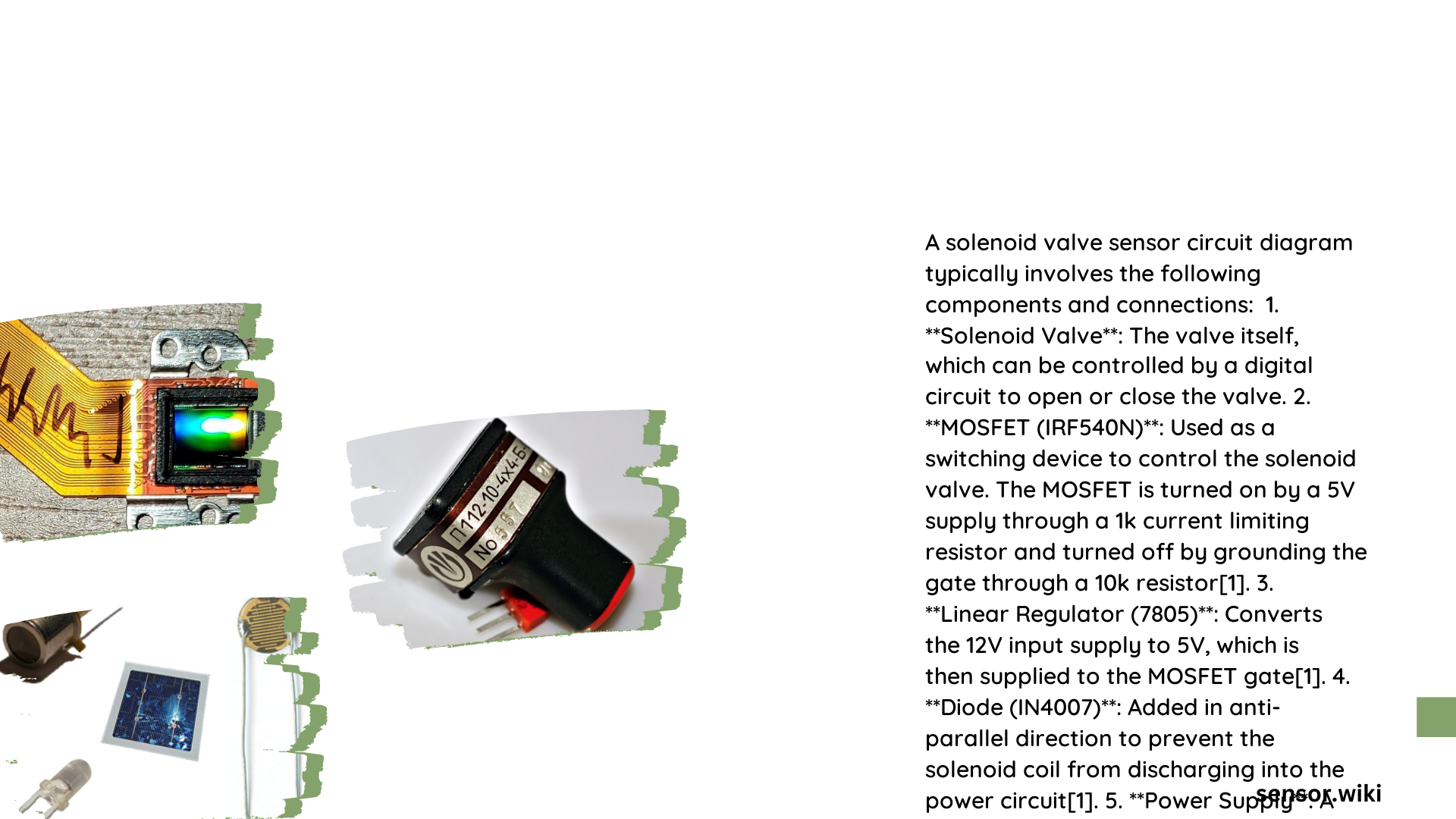A solenoid valve sensor circuit diagram is a crucial component in various industrial and automation applications. It illustrates the electrical connections and components required to control and monitor solenoid valves effectively. This diagram typically includes power supply connections, driver circuits, control logic, and feedback mechanisms to ensure precise operation of the valve.
What are the Key Components of a Solenoid Valve Sensor Circuit?
The solenoid valve sensor circuit comprises several essential components:
- Solenoid Valve
- Power Supply
- Driver Circuit (e.g., MOSFET or Relay)
- Control Logic (e.g., Microcontroller or PLC)
- Feedback Sensors (optional)
- Protection Components (e.g., Diodes, Fuses)
Each of these components plays a vital role in the overall functionality and reliability of the system.
How Does the Power Supply Connect to the Solenoid Valve?

The power supply connection is a critical aspect of the solenoid valve sensor circuit. Here’s a breakdown of the connection process:
- Identify the solenoid valve’s voltage requirements (e.g., 24VDC, 12VDC, 120VAC).
- Connect the positive terminal of the power supply to the positive terminal of the solenoid valve.
- Connect the negative terminal of the power supply to the negative terminal of the solenoid valve.
- Use appropriate wire gauge based on the current requirements (typically 18-20 AWG for low current applications).
- Ensure proper insulation and secure connections using terminal blocks or connectors.
It’s crucial to match the power supply voltage and current ratings with the solenoid valve specifications to prevent damage and ensure optimal performance.
What is the Role of the Driver Circuit in a Solenoid Valve Sensor Diagram?
The driver circuit is a fundamental component in the solenoid valve sensor circuit diagram. Its primary functions include:
- Amplifying the control signal to drive the solenoid valve
- Providing electrical isolation between the control logic and the high-power solenoid circuit
- Protecting the control logic from voltage spikes and back-EMF
A typical driver circuit may use a MOSFET or a relay, depending on the application requirements. Here’s an example of a basic MOSFET-based driver circuit:
+12V
|
|
[Solenoid]
|
|
[Diode]
|
|
Drain |
[MOSFET]-------+
Gate |
|
[Resistor]
|
Control Signal
In this circuit, the MOSFET acts as a switch, controlled by the input signal. The diode protects against back-EMF when the solenoid is de-energized.
How is Control Logic Implemented in the Solenoid Valve Sensor Circuit?
Control logic is the brain of the solenoid valve sensor circuit. It determines when and how the valve should operate. Implementation methods include:
- Microcontroller-based control
- PLC (Programmable Logic Controller) systems
- Dedicated control ICs
The control logic typically interfaces with the driver circuit through digital I/O pins or communication protocols like I2C or SPI. It may also receive input from sensors to make decisions based on system conditions.
What Feedback Mechanisms are Used in Solenoid Valve Sensor Circuits?
Feedback mechanisms are crucial for monitoring the state and performance of the solenoid valve. Common feedback methods include:
- Position sensors (e.g., Hall effect sensors, reed switches)
- Current sensors to monitor valve coil current
- Pressure sensors to detect successful valve actuation
These sensors provide valuable data to the control logic, enabling closed-loop control and fault detection.
How are Protection Components Integrated into the Circuit Diagram?
Protection components are essential for ensuring the longevity and reliability of the solenoid valve sensor circuit. Key protection elements include:
- Flyback diodes: Protect against voltage spikes from inductive loads
- Fuses or circuit breakers: Prevent overcurrent situations
- Voltage regulators: Ensure stable power supply to sensitive components
- Optocouplers: Provide electrical isolation between control and power circuits
Proper integration of these components helps prevent damage from electrical faults and extends the life of the system.
What are the Design Considerations for Solenoid Valve Sensor Circuit Layout?
When designing the layout for a solenoid valve sensor circuit, consider the following factors:
- Component Placement:
- Keep high-current paths short and away from sensitive signal lines
-
Place protection components close to the devices they protect
-
Grounding:
- Use a star grounding topology to minimize ground loops
-
Separate digital and analog grounds when necessary
-
Thermal Management:
- Provide adequate heat sinking for power components like MOSFETs and voltage regulators
-
Consider airflow and component orientation for efficient cooling
-
EMI/RFI Mitigation:
- Use shielded cables for sensitive signals
-
Implement proper filtering techniques to reduce electromagnetic interference
-
Serviceability:
- Design for easy access to test points and replaceable components
- Include status LEDs for quick diagnostics
By carefully considering these aspects, you can create a robust and reliable solenoid valve sensor circuit.
How to Troubleshoot Common Issues in Solenoid Valve Sensor Circuits?
When troubleshooting solenoid valve sensor circuits, follow these steps:
- Check power supply voltages and connections
- Verify control signals using an oscilloscope or logic analyzer
- Test the driver circuit functionality
- Inspect solenoid valve for mechanical issues
- Validate feedback sensor operation
- Examine protection components for signs of failure
Common issues and their potential causes:
| Issue | Possible Causes |
|---|---|
| Valve doesn’t actuate | Power supply failure, faulty driver circuit, broken wire |
| Intermittent operation | Loose connections, EMI interference, software glitches |
| Overheating | Incorrect voltage, stuck valve, driver circuit malfunction |
| False sensor readings | Faulty sensors, wiring issues, improper grounding |
By systematically addressing these potential problems, you can efficiently diagnose and resolve issues in solenoid valve sensor circuits.
In conclusion, understanding the intricacies of solenoid valve sensor circuit diagrams is crucial for designing, implementing, and maintaining reliable control systems. By carefully considering each component and their interactions, engineers can create robust solutions for a wide range of applications.
